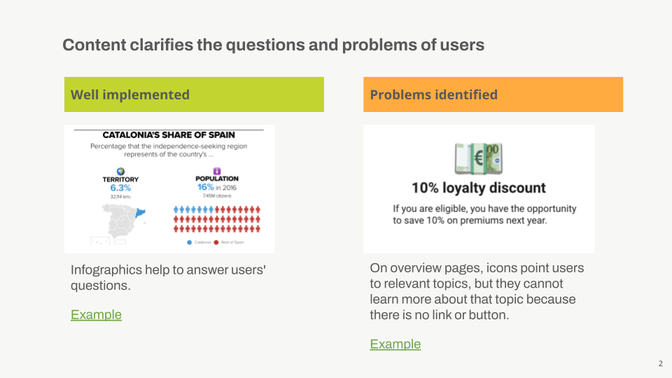How much content does your company have on its website? The chances are that few people can answer that question, as the volume of content on websites often grows organically. Website content includes static content, blog articles, knowledge content, news reports and more. The problem with having too much content is that the more content a website contains, the harder it is for visitors to find the answers to their questions. Users are left frustrated and will stop using the website and call customer support, or in the worst-case scenario, will move to a competitor’s website.
A qualitative content audit is a good way to identify which content is particularly relevant to both your organisation and your visitors. This will involve auditing a representative sample, rather than all of your website content. A content audit is a systematic web content analysis followed by a qualitative assessment. The aim of this is to boost the effectiveness and quality of the content. A content audit is comparable to a routine health check. You will identify what content needs to remain and what needs to be optimised or even removed from the website.

Side note: content inventory
Qualitative content assessments are time-consuming, which is why, as explained above, only a representative sample is audited. However, a content inventory is a good start if your company needs a complete overview of all its content. The aim is to gain a handle on the volume of content. A content inventory includes information about the page title, author, date of the last update, keywords, analytics data, subject area, multimedia content, downloads, the team responsible, and so on. Structured data such as the title, author and date of the last update can be obtained using the tool Screaming-Frog, saving you from having to search manually. A content inventory demonstrates the volume of content available, but does not offer any information about its effectiveness or quality. If you choose, you can select a sample from the content inventory to examine in more detail as part of a qualitative content audit.
When is a qualitative content audit worth doing?
Liip’s content strategists will often begin projects with a qualitative content audit. This provides us with baseline data to identify how we can best support your company. We recommend a content audit in the following five circumstances:
- Website relaunch
- Falling click-through figures / high bounce rate
- New corporate strategy
- Competitive market for web content
- No content governance strategy
Essentially, a content audit is always worthwhile if your content does not achieve the set objectives or if you feel your website is overloaded with content.
How a content audit works
Before you begin the audit itself, you should plan the process correctly; otherwise, the results will be of little value.
1. Aim of the content audit: What exactly do you want to find out from the content audit? An audit can have various objectives. Here are three examples:
-
Objective 1: Identify content that needs to be included and optimised for content migration.
-
Objective 2: Establish whether readers find suitably specific answers to their questions.
-
Objective 3: Determine whether the content is consistent and true to the brand.
2. Scope: You determine what content you are going to audit based on the audit objective. You can select the sample based on, for example, topics, data type (evergreen content, poorly performing content, etc.) or content type (with five to seven pieces of content of the same content type being analysed). If you have to sell the ongoing project internally, it is also worth conducting a gap analysis against the competition. A gap analysis looks at competitors’ content and highlights content differences and topic gaps. For example: a qualitative content audit of your website highlights that the content does not sufficiently touch on your personas’ pain points. You then examine similar content from your competitors. If other companies address this more effectively, you can persuade your management to invest in content optimisation and close the gap.
3. Audit-Kriterien: Liip’s content strategists define the audit criteria based on the set objectives. These criteria cover the effectiveness and quality of content. Here is a selection of possible criteria:
-
Content effectiveness: Comparison with corporate objectives, comparison with personas’ information needs, comparison with UX and information architecture good practices, content structure, subject relevance
-
Content quality: Spelling and grammar, style and readability, tone of voice (or communications strategy), structure/composition, factual accuracy/topicality, accessibility, appropriate preparation (for the target group, format and channel)
4. Preparing the results: It is important to define precisely how you will evaluate the criteria for qualitative methods, such as a qualitative content audit. Liip uses a traffic-light system for each audit criterion, making it easier for subsequent audit readers to identify problem areas in the web content without poring through the details. In doing this, it is important to define what red, orange and green mean within the traffic-light system. Here is an example:
- Green = content satisfactorily fulfils the criterion set
- Orange = content fulfils approx. 50% of the good practices set for a criterion
- Red = content fails to fulfil or insufficiently fulfils the criterion set

5. Audit grid and presentation of results: The audit itself will be recorded in a format such as an Excel document. For each audit criterion, you will see the green, orange or red status for each page examined, as well as a comment describing the potential for optimisation where relevant. These comments will subsequently help editors revise the content.
The results need to be presented in a way that both management and the content team can understand. Slides are suitable for this. As well as the traffic-light system described above, we also set out the current status of each individual audit criterion and give positive and negative examples using screenshots (see picture). We split our results into quick wins and potential for optimisation, depending on how time-consuming it will be to revise the content.

Three tips from Liip’s content strategists
-
If multiple people are involved in the audit, it is worth comparing results after each person has audited three or four pages. Compare the type of results: are they consistent? If not, you need to further hone your audit criteria.
-
Begin creating the presentation of results alongside the content audit list. As you do so, you will continually collect screenshots of good and bad examples to highlight your argument. This will save a lot of time.
-
Decide the best way of working for you. Usually, you would look at a single page and analyse all of the audit criteria in turn. However, some people work more quickly, tackling one audit criterion at a time and moving back and forth between pages.
What happens after the content audit?
There are various follow-up activities depending on the set objectives. In most cases, the content team will get involved and revise the existing content based on the identified quick wins and optimisation measures. A/B testing may also be performed to test and validate multiple possible solutions. Content covering the same topic will often be combined onto one page in consultation with SEO experts. If your organisation does not yet have any content governance in place, now is a good time to define who and in what intervals the content provided will be reviewed on topicality and relevance. This will help to prevent the content from growing out of control in the future.
Do you have any further questions about how to structure and prepare web content? Our content strategists would be happy to help you.

